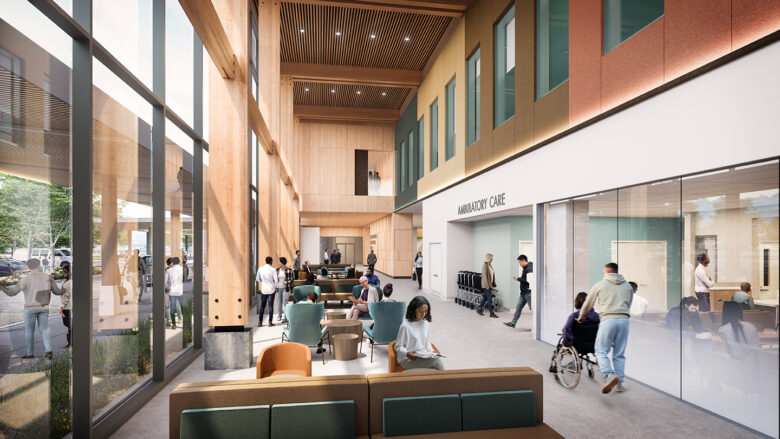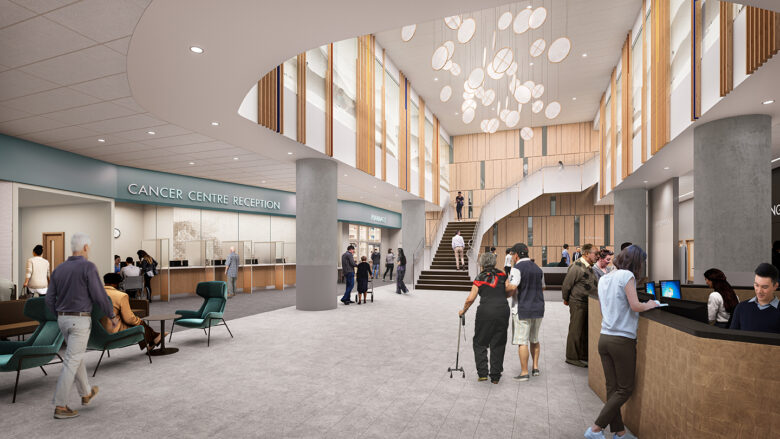Sector: Healthcare
Confidential Client
Space Utilization Dashboards
This dashboard solution transformed challenging conversations around space allocation into more informed decisions, enhancing efficiency and maximizing resource utilization for the organization.
This Canadian healthcare campus is comprised of three acute care hospitals, a rehabilitation facility, and various specialized and support facilities, making it one of the busiest hospital networks in the country.
In an environment where clinical space is constantly in high demand and various departments are always seeking additional space allocations, the campus network faced the challenge of balancing the ongoing demands for more space against the available assets. The need to gain insights into how these spaces were utilized and by whom was paramount in effectively optimizing space allocation.
To address this challenge, the client enlisted the expertise of HH Angus, a long-standing partner, to implement an occupancy monitoring solution. The project goal was to assess the utilization of clinical spaces and identify opportunities for improvement. A longer-term goal was to gather real-world data to inform the design of new spaces, ensuring they met needs identified through the measurement and analysis of current use data.
As part of the collaboration, numerous IoT devices were deployed across two rapid assessment centres, utilizing a variety of technologies to capture occupancy data. This near real-time data was then seamlessly integrated into a unified platform hosted on Amazon Web Services (AWS).
HH Angus designed and implemented a strategic approach to efficiently manage administrative department requests for additional space. Specialized occupancy sensors were tailored to meet the client’s requirements for accuracy and data granularity. Collaborating closely with the hardware vendor, HH Angus managed the entire installation and commissioning process. The result was a sophisticated cloud-based database and dashboard that empowers campus staff with comprehensive insights into space usage.

Road mapping and prioritizing sites were essential for large-scale implementation, and ongoing collaboration with the client ensures alignment with their long-term goals. The solution has already facilitated a departmental reallocation, demonstrating the practical benefits of the implemented system. Another benefit of the occupancy data collection is the ability to reallocate space to other departments as work-from-home initiatives create a more flexible work environment.
The sustainability features of this project are evident through its efficient use of office space, enabled by data driven insights. By implementing a tailored occupancy sensor solution, the project minimizes wasted space and energy resources, aligning with sustainable practices.
Medical privacy considerations, such as avoiding image processing, ensure that ethical guidelines are reflected in the technology deployed. Additionally, a continuous focus on accuracy maintenance enhances the longevity and effectiveness of the solution, reducing the need for frequent hardware replacements and minimizing associated environmental impact.
By leveraging AWS Quicksight, the collected data was transformed into actionable insights. Some of the notable benefits include acquiring reliable and actionable data, receiving an easy-to-understand insights dashboard, and utilizing this data and visualization tool to gauge the effectiveness of the client’s new Rapid Assessment Centre layout to inform future space layout decisions. This initiative reflects the client’s commitment to enhancing operational efficiency and improving patient care through innovative solutions.
SERVICES
Smart Building Consultants
PROJECT FEATURES
Tailored space optimization | Reliable accuracy | Privacy-compliant technology | Accessible data insights | Status: Completed 2023 plus continuing contract
LOCATION
Toronto, Ontario
KEY SCOPE ELEMENTS
Designed and implemented strategic approach to efficiently manage administrative department requests for additional space | Road mapping and prioritization of sites for large-scale implementation | Manage installation and commissioning process.
Infrastructure Ontario
Grandview Children's Centre Redevelopment
The Grandview Children's Centre is the new headquarters for Grandview Kids, specializing in care and support for children and youth with physical, communication and developmental needs, and their families.
The 94,744 ft2, 4-storey educational and treatment facility includes centre-wide therapy services, such as occupational therapy, physiotherapy, speech-language pathology, therapeutic recreation, audiology, infant hearing, blind low vision and social work. The building contains a therapy pool area which includes an integrated AV system to create a more relaxing and therapeutic environment. It also offers autism services, a preschool outreach program, school-based rehabilitation services, developmental pediatrics, including specialized medical clinics, and family/caregiver resources and support. The facility is home to the Grandview School, as well as a branch of the Ajax Public Library. The building site also features a therapeutic trail that integrates security into the landscaping for added safety while maintaining the appearance of being surrounded by nature.
The project was delivered through the P3 (Design Build Finance) model and won the Award of Merit for Project Development at the Canadian Council for Public-Private Partnership’s (CCPPP) 2022 National Awards for Innovation and Excellence in Public-Private Partnerships.
Image courtesy of Grandview Kids
SERVICES
Mechanical Engineering | Electrical Engineering | Information and Communications Technology | Vertical Transportation
PROJECT FEATURES
Size: 94,744 ft2 | Status: Completed 2024 | P3-DBF | CCPPP 2022 Award of Merit for Project Development
LOCATION
Ajax, Ontario
KEY SCOPE ELEMENTS
Integrated Grandview School and Ajax Public Library branch
Build Nova Scotia
Cape Breton Hospital Redevelopment
The value of an integration strategy is to streamline integration use case development and to implement only the integrations that are most useful to the users.
Angus Connect was engaged as a Master Systems Integrator by Build Nova Scotia (BNS) to produce an Integration Strategy and Implementation Plan for Cape Breton Regional Hospital (CBRH). CBRH is currently undergoing a large, multi-year redevelopment to redesign and rebuild healthcare infrastructure to support patients, families, healthcare staff, and researchers. The existing facility is undergoing a renovation in addition to construction of three new buildings:
- Energy Centre - to provide power and heat to the new expansion and the existing facility
- Cape Breton Cancer Centre - to house dedicated services for patients undergoing cancer treatments, and their families
- Clinical Services Building - to serve as main referral and trauma centre for Cape Breton Island
Initial Goal of the Project
Angus Connect collaborated with BNS, CBRH, and other key stakeholders to create a comprehensive integration plan aligned with the redevelopment project’s overall vision, and the building and clinical systems in the existing and new buildings. The focus of the integration strategy and implementation plan was to:
- Achieve a thorough understanding of existing building conditions
- Define the organization’s vision and goals related to integration
- Develop a complete list of user requirements in the form of integration use cases
- Identify gaps or issues with existing systems and recommend high level strategies for resolution
- Develop implementation documents for further planning and costing
- Manage potential risks through early identification and discussion
- Facilitate a smooth deployment of new system integration
The value of an integration strategy is to streamline integration use case development and to implement only the integrations that are most useful to the users. Often integrations are noted in
engineering design documents; however, they are generally high level and may not include actual use cases that describe the action the client wishes to achieve. Our role is to delve more deeply into processes, determine which use cases the users want, and determine feasibility. We can then produce design documents for those integrations that describe how the integrations will take place, and how to assess success.
Challenges/Solutions
The client wanted an integration strategy and implementation plan that would:
- Complete a current state assessment of the existing facility and the redevelopment design documents to identify current challenges, opportunities, and integrations that were already included in the redevelopment cost
- Develop an integration vision to help guide the organization in the implementation of integrations
- Ensure the integrations being implemented were helpful to users (not just done for the sake of being done)
- Ensure the integrations being implemented had a good ROI
- Identify potential issues or risks, such as technology decisions not yet taken
- Develop a ‘roles and responsibilities’ matrix for integration use cases
Essentially, the client wanted to implement realistic integrations that made sense for the use case, helped staff and users, were not too complex, and not too expensive. Similar to many other rural healthcare organizations, the project was sensitive to cost and to ongoing support requirements (ie. staff who know how to manage these integrations in future)
How It Was Achieved
Through leadership interviews, visioning session, and end-user meetings, we developed an integration vision and list of integration use cases to improve the user experience, allow for seamless communications, and improve situational awareness of building operations. Our team’s technical knowledge of building systems, clinical systems, and integration models ensured our recommendations were grounded in reality while also meeting CBRH’s vision for an integrated and connected future.
Key Takeaways
As a part of our current state assessment, we visited CBRH to see the building and clinical systems in action and met with users to better assess their current workflows. We believe this step to be vitally important to truly understanding existing conditions. While review of existing documentation and virtual meetings are a critical component to gathering information on existing systems, understanding current workflows, identifying potential issues, and brainstorming potential improvements all benefit from in-person consultation
SERVICES
Master Systems Integrator
PROJECT FEATURES
Size: 5,600,000 ft2 | Status: Ongoing
LOCATION
Cape Breton, Nova Scotia
KEY SCOPE ELEMENTS
A comprehensive integration strategy and implementation plan | Ensure ROI | Identify potential issues or risks | Develop roles & responsibilities matrix
Fraser Health
New Surrey Hospital and BC Cancer Centre
Surrey BC is a fast-growing community in need of additional healthcare resources. The New Surrey Hospital and BC Cancer Centre will provide 168 hospital beds and 55 Emergency Department treatment spaces in a state-of-the-art facility to improve health services in the region.
The $2.88B hospital project reached its one-year construction milestone in August 2024 and is anticipated to be completed in 2029 and open to the public in 2030. Additional features of the fully-electric facility include a surgical/perioperative suite with five ORs, four procedure rooms and virtual care options in all clinical service areas to increase capacity and expand care. The new BC Cancer Centre is expected to provide approximately 105,000 ambulatory oncology care visits, 50,000 radiation therapy visits and 22,000 chemotherapy visits each year. The facility is being built under a Design-Build Agreement with EllisDon Design Build Inc.
Leading BC's first generation of smart hospitals, the new Surrey hospital will embed data insights and new technologies into both the design of the facility and delivery of clinical care. The Angus Connect team is providing a full spectrum of ICAT/IMIT design and AGV consulting, and HH Angus’ Vertical Transportation team is designing the elevator systems.
Images courtesy of Fraser Health and EllisDon Design Build – conceptual renderings, subject to change
SERVICES
ICAT/IMIT Design | AGV Consulting | Vertical Transportation Consulting
PROJECT FEATURES
Smart hospital | Fully electric facility | Design Build | 168 hospital beds, and 55 ER beds | Perioperative suite with 5 ORs and 4 procedure rooms | Status: Completion anticipated for 2029
LOCATION
Surrey BC
KEY SCOPE ELEMENTS
Information, communications and automation technology | Automated guided vehicle design consulting | elevator design consulting

New BC Cancer Centre
The facility will provide ~105,000 ambulatory oncology care visits, 50,000 radiation therapy visits and 22,000 chemotherapy visits annually.
Smart hospitals
The NSHBCCC is one of BC's new generation of smart hospitals.

King Animal Hospital
Fitout and Peer Review
The King Animal Hospital is a state-of-the-art multidisciplinary referral and emergency hospital for small animals and equines, complete with MRI’s and medical gas systems.
HH Angus provided mechanical consulting services for the fitout of the King Animal Hospital. Our scope of work included a peer review and report identifying potential gaps between the base building mechanical infrastructure and the programming and capacity requirements for the state-of-the-art animal hospital. Following the peer review and report, we provided full mechanical design services for the fitout, from schematic design through to construction administration and project close-out.
The fitout included approximately 60,000 FT2 in a 4-storey greenfield facility, accommodating a wide range of program elements including 8 operating rooms, 12 exam rooms, an MDRD sterilization room, laboratory and pharmacy, diagnostic imaging (MRIs, CT Scan) suites, hydrotherapy, and physiotherapy, as well as support and administrative spaces.
The sub-cellar is home to an equine treatment area with CT equipment outfitted with robotic arms, and an MRI with an adjacent horse lift. An arena will be used for equine physiotherapy. A large heated ramp from grade was selected over an animal elevator to provide a safer, and less stressful, mode of transportation for the horses when moving between floors. The small animal services area of the sub-cellar features three aquatic treadmills, a hydrotherapy pool, and a hyperbaric oxygen chamber.
The cellar level includes the staff gym, lounge, meeting areas, and a dog quarantine with an exam room and 17+ dog runs. Oxygen connections to the cages and foot baths in the floor support infection prevention and control.
The ground floor features an equine surgical area, including recovery, dirty surgery area (two surgeries performed simultaneously), and an equine water treadmill. It also houses a treatment area for dogs, cats and exotics, including dentistry area, and a canine showcase area with three surgery, CT, x-ray and neurological rooms with MRI equipment.
The second floor houses staff meeting spaces and amenities. A multipurpose space doubles as a surgical support area, Learning Centre, and workshop.
The base building infrastructure was in place prior to HH Angus joining the project, which meant our team was tasked with working in the confines of a building shell that was already in place. This presented challenges at the cellar level, where the team had to design while accounting for low floor to floor heights.
The hospital had not yet retained any permanent staff during the design stage, and many of the programming elements relied on recommendations from other consultants/doctors/experts during the design-stage user group meetings. Once permanent staff were hired for key departments, the design team worked with the client to make adjustments to the layouts and equipment based on staff input.
Although an animal hospital does not fall under the same CSA standards required for human
hospitals, there is a trend towards meeting those standards in animal care facilities. HH Angus wrote design briefs for systems and features that the client chose for this facility, many of which aligned with CSA requirements for a state-of-the-art human hospital.
SERVICES
Mechanical Engineering | Peer Review
PROJECT FEATURES
Size: 60,000 ft2 | Status: Completed 2024
LOCATION
King City, Ontario
KEY SCOPE ELEMENTS
Spaces for diagnostic imaging, hydrotherapy, surgery, physiotherapy, and support and administrative space | Therapy arena and pools | Staff amenities
